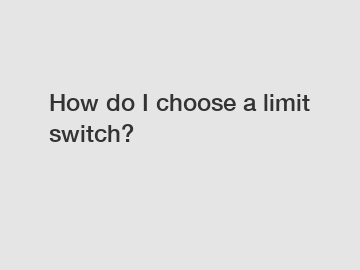How do I choose a limit switch?
TMAZTZ are exported all over the world and different industries with quality first. Our belief is to provide our customers with more and better high value-added products. Let's create a better future together.
How do I choose a limit switch?
Limit switches play a critical role in various industries, providing a necessary safeguard for machinery and equipment. However, with the wide range of options available, choosing the right limit switch for your specific application can be a daunting task. Factors such as the type of machinery, environment, and required functionality need to be carefully considered. In this article, we will guide you through the process of selecting a suitable limit switch, ensuring optimal performance and safety.

Understanding the Basics of Limit Switches.
Before delving into the selection process, it is important to have a clear understanding of what a limit switch does. A limit switch is an electromechanical device that detects the presence or absence of an object within its predefined range. It operates by using a physical actuator, typically a lever, roller, or plunger, to activate or deactivate a set of electrical contacts.
Identifying Your Application Requirements.
The first step in selecting a limit switch is identifying the specific requirements of your application. Consider the type of machinery involved, the environmental conditions, and the desired functionality. For example, if you are operating in a highly corrosive or wet environment, you will need a limit switch with a high degree of protection, such as an IP67 rating. Similarly, if precise positioning of the actuator is crucial, a switch with adjustable or multiple actuation points may be required.
Choosing the Right Switching Mechanism.
Next, you need to determine the appropriate switching mechanism for your application. There are various types to choose from, including lever, roller, plunger, and proximity. Lever switches are commonly used when a physical object needs to activate the switch, while roller switches are ideal for applications with rolling objects. Plunger switches, on the other hand, are suited for situations where direct contact with the object is necessary. Proximity switches, using non-contact sensing technology, are often preferred in industries where repetitive motion is involved.
Evaluating Environmental Factors.
The environment in which the limit switch will operate plays a critical role in its performance and longevity. Consider factors such as temperature extremes, moisture levels, dust or debris, and exposure to chemicals. These conditions can impact the switch's sealing, durability, and overall reliability. It is important to select a switch that is designed to withstand the specific environmental challenges of your application.
Reviewing Electrical Requirements.
In addition to the mechanical considerations, it is important to review the electrical requirements of your application. This includes factors such as voltage, current, and load capacity. Ensure that the limit switch you choose is compatible with your electrical system and can handle the required voltage and current levels. Additionally, consider the type of electrical contacts required - normally open (NO), normally closed (NC), or both - based on the specific needs of your application.
Consulting with Experts.
While this article provides a comprehensive guide to selecting a limit switch, it is always beneficial to consult with industry experts. They can offer valuable insights and recommendations based on their experience and expertise. Reach out to manufacturers or suppliers who specialize in limit switches to discuss your application requirements and receive personalized guidance.
Contact us.
If you have any further questions or need assistance in choosing the right limit switch for your application, please do not hesitate to contact us. Our team of experts is dedicated to helping you find the most suitable solution for your needs.
In conclusion, choosing a limit switch requires a careful evaluation of application requirements, switching mechanisms, environmental factors, and electrical considerations. By understanding these key factors and seeking expert advice when needed, you can ensure the selection of a limit switch that meets your specific needs, providing optimal performance and safety for your machinery or equipment.
You can find more information on our web, so please take a look.
The company is the world’s best Coil Spring Lever Limit Switch supplier. We are your one-stop shop for all needs. Our staff are highly-specialized and will help you find the product you need.



